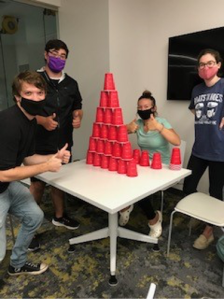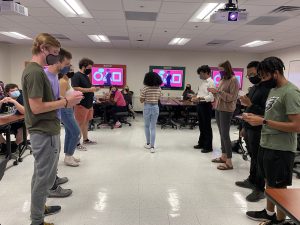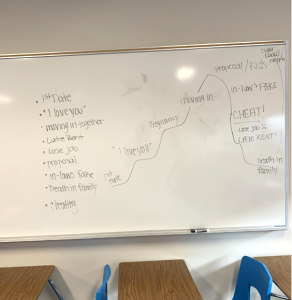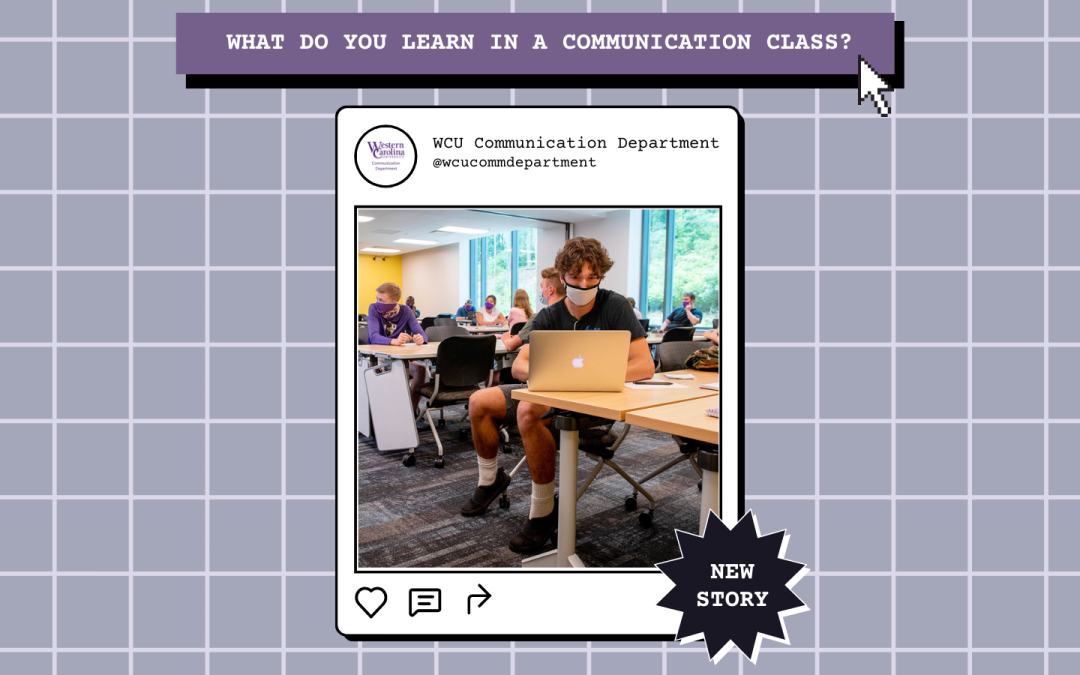All industries require good communication skills, but what does a communication class really look like?
Western Carolina University’s Communication Department offers a variety of communication courses that enhance student learning with innovative activities and engaging curriculum material.
Instructors of three of these communication courses – Foundations of Communication, Communication Theory, and Interpersonal Communication – introduced new and unconventional ways of teaching material and concepts to their students last semester.
_____________________
Professor Susan Schall teaches Foundations of Communication (COMM 201), which focuses on basic principles of communication skills and theory for interpersonal, small group and public communication. This is a required course for all undergraduate students as part of the liberal studies curriculum at Western.
Schall has been teaching at Western since 2020 and has a master’s degree in speech communication from Pennsylvania State University. She has been teaching in the higher education field since her time as a teacher’s assistant in graduate school, and previously taught at Mitchell Community College in Statesville, North Carolina.
Schall’s COMM 201 class focuses on small group interaction in which students are assigned a group for the semester where they support each other and do activities in class.
 One topic her students covered last semester was leadership in small group communication. To illustrate the importance of leadership and group roles, Schall implemented an activity where students had to work together to build a pyramid of red solo cups. The activity was challenging because each group had to increase the height of their pyramids by adding cups to the bottom of their structure.
One topic her students covered last semester was leadership in small group communication. To illustrate the importance of leadership and group roles, Schall implemented an activity where students had to work together to build a pyramid of red solo cups. The activity was challenging because each group had to increase the height of their pyramids by adding cups to the bottom of their structure.
Initially, students did not know the purpose of the activity.
“I am not sure they realized we were doing more than just messing around with cups for a while. But during the debrief, they could see what I was trying to do,” said Schall.
Because they worked in their established groups since the beginning of the semester, the students had a rapport built with one another and worked seamlessly to complete the activity. This reinforced the concept of group roles and leadership that Schall was teaching.
_____________________
Dr. Candy Noltensmeyer teaches Communication Theory (COMM 350), which covers a survey of theoretical genres used across various communication disciplines. This is a required course for all communication majors and minors as well as journalism minors.
Noltensmeyer has been teaching at Western since 2012 and has been teaching communication for 18 years. She has a doctorate in communication from the University of Missouri. Noltensmeyer has been teaching since her time in graduate school, where her love for teaching started.
Noltensmeyer currently teaches interpersonal communication, communication theory and research methods. In the past, she has also taught family and close relationships, foundations of communication and sex and sexuality.
Noltensmeyer approaches her communication theory class in an applied fashion and works to make direct applications of each theory she teaches.
She implements two assignments in class that “make a big impact on class culture and the willingness to apply principles of theory to students’ lives.”
“The first assignment asks students to choose a song that fits some part of the theory and tell the class how it fits. The second assignment asks students to create an activity that demonstrates the theory,” explained Noltensmeyer.
One student in Noltensmeyer’s theory class last semester created a unique and engaging activity to illustrate the social exchange theory.
 Following the premise of the hit Netflix series, Squid Game, this student focused on how individuals choose competition partners without knowing the game they are playing.
Following the premise of the hit Netflix series, Squid Game, this student focused on how individuals choose competition partners without knowing the game they are playing.
“This represents how often we choose partners for work or personal relationships without knowing what part they may play in our lives,” explained Noltensmeyer.
The activity consisted of two games: ddakji, a traditional South Korean game, and rock-paper-scissors. In ddakji, students choose a partner and attempt to flip a card over using another similar card. The winner of the first game went on to play rock-paper-scissors, and the final winners received large candy bars as their prize.
The activity was received very well by Noltensmeyer’s students.
“Everyone was up out of their seats so they could watch and cheer on their classmates,” said Noltensmeyer.
After the activity, Noltensmeyer facilitated a class discussion on the nuances of costs and rewards across a variety of relationship types.
“This particular activity really highlighted the multiple perspectives of what a cost or reward looked like to different folks and how widely it varied,” said Noltensmeyer.
_____________________
Professor Shelby Broberg teaches Interpersonal Communication (COMM 301), which concentrates on basic theory and skills in interpersonal communication including gender, nonverbal, listening, and interviewing skills. This is one of the four classes that communication majors can choose from to fulfill Core requirements.
Broberg has been teaching at Western since 2018 and has been teaching communication for six years. She received her master’s degree in communication studies from Arizona State University. At Western, Broberg teaches foundations of communication and interpersonal communication.
In her interpersonal communication class, Broberg focuses on the way we talk to one another in our various relationships, including friendships, family members, romantic partners, and workplace acquaintances.
 To demonstrate the different stages in a relationship, Broberg put students in small groups and assigned each group a section of the class whiteboard to identify seven turning points that would cause a change in a relationship.
To demonstrate the different stages in a relationship, Broberg put students in small groups and assigned each group a section of the class whiteboard to identify seven turning points that would cause a change in a relationship.
Students had to further identify whether the turning point would cause a positive or negative change. Finally, the students mapped out the order these turning points might happen and whether they would help or hurt the relationship.
“Ultimately, [this activity} shows that our relationships are not linear and are full of unique ups and downs,” said Broberg.
 Students pull from their own experiences while engaging in this activity by reflecting on memories in their friendships or partnerships.
Students pull from their own experiences while engaging in this activity by reflecting on memories in their friendships or partnerships.
“Students get pretty invested in this activity… [which] helps them understand the concept of Relational Turning Points because it lets them visualize and relate to specific moments in relationships and why they’re impactful,” explained Broberg.
Broberg believes when students are active participants in learning, it is much easier for them to understand ideas and have them stick with students better.
_____________________
The skills and theories taught in communication courses are applicable in a variety of ways and across many areas, including our careers, relationships, social interactions, and decisions.
Studying communication theories and concepts does not apply only to those students who are pursuing a career in the field. The takeaways from communication classes such as these three are relevant and impactful for all students in college and in their future careers.
Good communication skills and a solid understanding of communication processes are desirable traits looked for by employers of many industries. According to a recent article on the employment website, Indeed.com, the top skills most desired in their employees include communication skills, leadership, teamwork, interpersonal skills, problem-solving skills, and the ability to learn and be adaptable. Students can set themselves apart in both the classroom and the workforce by engaging in communication courses and applying concepts learned from activities like the ones highlighted here.

